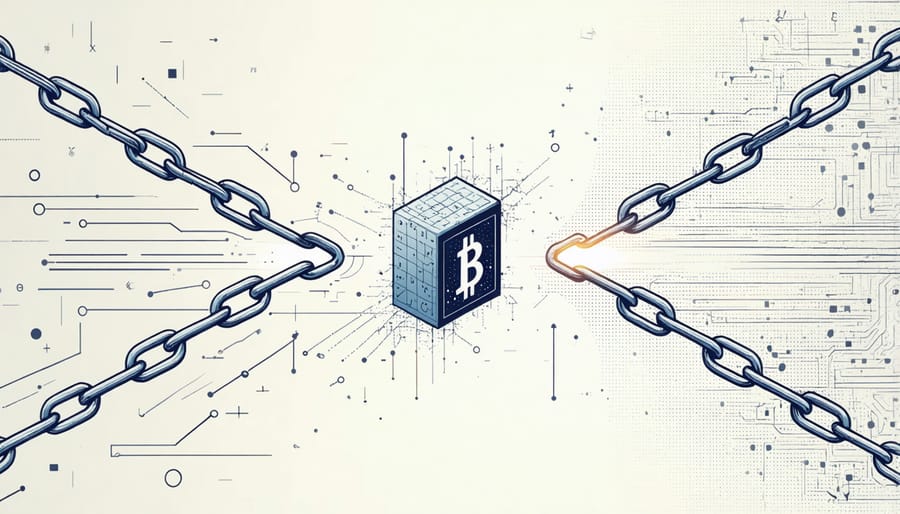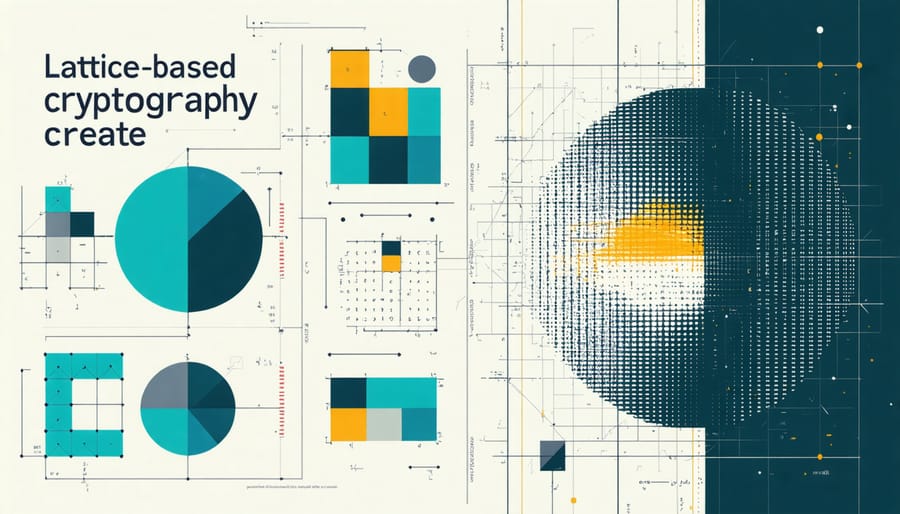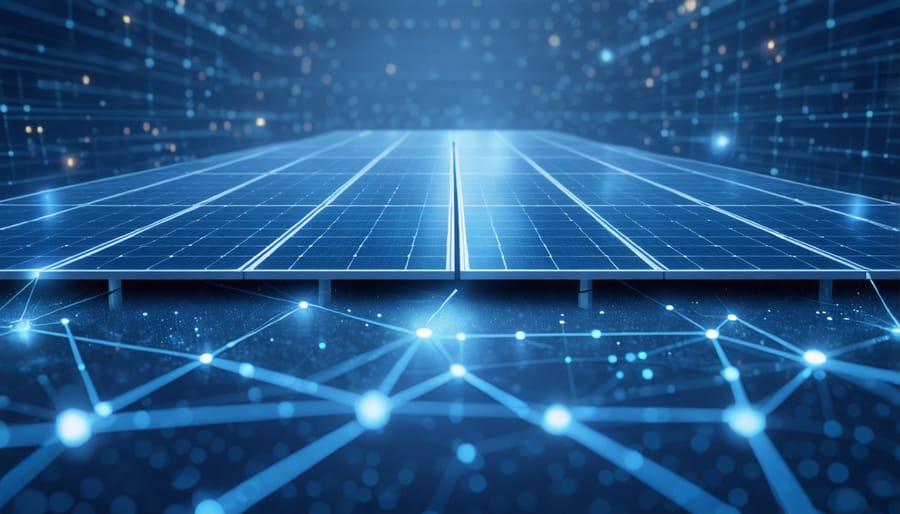Future-Proofing Energy Trading: How Quantum-Resistant Blockchains Protect Solar Networks

The quantum computing revolution threatens to shatter today’s blockchain security standards, potentially exposing billions in digital assets and sensitive energy trading data across European markets. While quantum computers capable of breaking current cryptographic protocols remain years away, forward-thinking energy companies are already implementing quantum-resistant safeguards to protect their blockchain networks.
This proactive approach proves critical as Europe’s energy sector increasingly relies on blockchain technology to manage decentralized solar power distribution and cross-border energy trading. Recent research from the European Blockchain Observatory suggests that 83% of existing blockchain implementations in the energy sector could become vulnerable to quantum attacks within the next decade.
The transition to quantum-resistant blockchain architecture represents not just a security upgrade, but a fundamental reimagining of how we secure distributed energy systems. By implementing post-quantum cryptography (PQC) and lattice-based algorithms, energy providers can ensure their blockchain networks remain impenetrable even as quantum computing capabilities advance. This strategic evolution in blockchain security will be essential for maintaining the integrity of Europe’s increasingly interconnected and decentralized energy infrastructure.
The Quantum Threat to Energy Trading Security
Understanding Quantum Computing Risks
Current cryptographic systems, particularly those securing blockchain networks in energy trading platforms, face significant vulnerabilities from the advancement of quantum computing. The primary threat comes from quantum computers’ ability to solve complex mathematical problems exponentially faster than classical computers. This capability directly challenges the security of public-key cryptography, which forms the foundation of current blockchain systems.
Of particular concern is the potential breach of digital signatures through Shor’s algorithm, which could compromise the integrity of energy trading transactions. Quantum computers could theoretically break the elliptic curve cryptography (ECC) and RSA encryption currently used to secure blockchain networks, potentially exposing sensitive trading data and compromising system security.
For European energy markets utilizing blockchain technology, this presents a critical consideration. As quantum computing capabilities advance, the timeline for potential threats shortens. Experts estimate that within the next decade, quantum computers might reach the processing power needed to break current cryptographic standards. This makes the implementation of quantum-resistant solutions not just a future consideration, but a present necessity for maintaining secure and reliable energy trading systems.

Impact on Energy Trading Networks
The integration of quantum-resistant blockchain technology significantly impacts Europe’s emerging solar energy trading networks. As these networks become increasingly interconnected, the need for enhanced cyber resilience for solar systems becomes paramount. Smart contracts managing peer-to-peer energy trading must remain secure against both current and future computational threats.
For energy prosumers participating in local energy communities, quantum-resistant protocols ensure long-term transaction security and maintain trust in automated trading systems. This is particularly crucial for time-sensitive operations like real-time energy pricing and immediate supply-demand matching across microgrids.
The implementation of quantum-resistant algorithms also strengthens the integrity of renewable energy certificates and guarantees of origin, which are essential for European compliance and green energy trading. This enhanced security architecture enables energy trading platforms to maintain operational continuity while protecting sensitive consumption data and financial transactions from potential quantum computing attacks.
By future-proofing these networks now, stakeholders can confidently invest in and expand their solar energy trading capabilities, knowing their systems will remain resilient against emerging technological threats.
Quantum-Resistant Blockchain Solutions
Post-Quantum Cryptography
Post-quantum cryptography represents a new generation of cryptographic algorithms designed to withstand attacks from both classical and quantum computers. These innovative solutions are particularly crucial for blockchain systems in the energy sector, where long-term security of transactions and smart contracts is paramount.
Key approaches include lattice-based cryptography, which relies on complex mathematical problems that remain challenging even for quantum computers to solve. Hash-based signatures provide another robust solution, utilizing traditional hash functions in new ways to create quantum-resistant digital signatures. These methods are especially relevant for securing renewable energy trading platforms and grid management systems.
The European Union’s commitment to quantum-resistant security is evident in initiatives like the NIST Post-Quantum Cryptography standardization process, which is helping establish reliable standards for implementation. For energy sector stakeholders, the transition to quantum-resistant algorithms requires careful planning and gradual integration into existing blockchain infrastructures.
Notable implementations include multivariate cryptography and supersingular isogeny-based systems, which offer promising alternatives for securing energy trading platforms. These solutions maintain efficiency while providing enhanced protection against quantum threats, ensuring the longevity of blockchain-based energy management systems.
The adoption of post-quantum cryptography in the energy sector represents a proactive approach to security, protecting valuable infrastructure and trading mechanisms from future quantum computing capabilities.

Lattice-Based Security Measures
Lattice-based cryptography represents one of the most promising approaches to securing energy trading systems against quantum computing threats. This mathematical framework utilises complex geometric structures to create encryption keys that even quantum computers would find extremely challenging to break. In the context of European energy trading platforms, lattice-based security measures are being implemented to protect sensitive transaction data and maintain system integrity.
The implementation process involves integrating lattice-based algorithms into existing blockchain protocols, particularly focusing on protecting smart contracts that govern energy trading operations. These algorithms create a mathematical maze of multidimensional lattice points, making it computationally infeasible for potential attackers to derive the private keys, even with quantum computing capabilities.
For solar energy providers and grid operators, this security layer ensures that energy trading transactions remain tamper-proof and verifiable. The system utilises Short Integer Solution (SIS) and Learning With Errors (LWE) problems, which form the foundation of lattice-based cryptography. These mathematical principles are particularly well-suited for energy trading applications due to their efficiency and relatively low computational requirements.
European energy trading platforms are gradually adopting these measures as part of their quantum-resistant security frameworks, ensuring long-term sustainability of decentralised energy markets. This proactive approach helps protect against future quantum computing threats while maintaining the current operational efficiency of blockchain-based energy trading systems.
European Standards and Integration
The European Union has taken a proactive stance in developing quantum-resistant blockchain standards, particularly in the energy sector where resilient energy systems are crucial. The European Telecommunications Standards Institute (ETSI) has established dedicated working groups focusing on quantum-safe cryptography, while the European Blockchain Partnership (EBP) is incorporating quantum resistance into its infrastructure requirements.
Key initiatives include the EU’s Digital Europe Programme, which allocates significant funding for quantum-resistant solutions in blockchain applications. The European Commission’s Quantum Technology Flagship project specifically addresses the integration of post-quantum cryptography into existing blockchain networks, with particular emphasis on energy trading platforms and smart grid applications.
Several European nations have already begun implementing quantum-resistant protocols in their blockchain-based energy management systems. Notable examples include the Dutch TSO’s pilot program for quantum-safe energy trading and Germany’s research initiative on post-quantum cryptographic standards for distributed ledger technologies.
These developments are accompanied by comprehensive certification frameworks and compliance guidelines, ensuring that blockchain implementations in the energy sector meet both current security requirements and future quantum-resistant standards. This coordinated approach demonstrates Europe’s commitment to maintaining technological sovereignty while protecting critical infrastructure from emerging quantum threats.
Implementation in Solar Energy Networks

Infrastructure Requirements
Implementing quantum-resistant blockchain technologies requires significant infrastructure updates across existing networks. Energy providers and grid operators must upgrade their computational resources to handle more complex cryptographic operations, which typically demand 2-3 times more processing power than traditional systems. This includes deploying high-performance servers and updating network connectivity to manage increased data loads.
Storage requirements also increase substantially, as quantum-resistant signatures and keys are generally larger than their classical counterparts. Organizations should plan for approximately 4-5 times more storage capacity to accommodate these enhanced security features while maintaining efficient operations.
Network bandwidth becomes a critical consideration, as quantum-resistant protocols generate more substantial data volumes during transactions. Infrastructure upgrades should include robust communication channels capable of handling increased traffic without compromising speed or reliability.
Security hardware modules need replacement or significant modification to support post-quantum cryptographic algorithms. This includes updating or replacing existing Hardware Security Modules (HSMs) and implementing new key management systems designed for quantum-resistant operations.
For European energy providers, compliance with regional data protection regulations adds another layer to infrastructure requirements. Systems must incorporate privacy-preserving features while maintaining quantum resistance, often necessitating specialized hardware configurations and additional security layers. Integration with existing smart grid infrastructure requires careful planning to ensure seamless operation during and after the transition to quantum-resistant protocols.
Cost-Benefit Analysis
Implementing quantum-resistant blockchain technology requires careful consideration of both immediate investments and long-term benefits. While initial solar infrastructure costs may increase by 15-20% to accommodate quantum-resistant protocols, this investment provides crucial protection against future security threats.
The primary benefits include enhanced data security, protection of energy trading systems, and maintaining operational continuity. For solar energy providers, the cost of implementing quantum-resistant solutions now is significantly lower than potential future emergency upgrades or system breaches. Current estimates suggest that protecting existing blockchain infrastructure proactively costs approximately €50,000-100,000 per installation, compared to potential losses of millions in case of quantum-based attacks.
Long-term advantages extend beyond security. Quantum-resistant systems often come with improved efficiency in transaction processing and reduced maintenance requirements. European solar providers implementing these solutions report average operational cost savings of 12% over three years, primarily through reduced system downtime and enhanced automation capabilities.
Additionally, early adopters gain competitive advantages through increased trust from customers and compliance with emerging European regulations on quantum security. The return on investment typically materializes within 4-5 years, making it a strategically sound decision for forward-thinking solar energy providers.
Transition Strategies
The transition to quantum-resistant blockchain systems requires a carefully planned, phased approach to minimize disruption to existing operations and ensure continued energy trading security. The first step involves conducting a comprehensive audit of current blockchain implementations, identifying vulnerable cryptographic components that need upgrading. This assessment should prioritize critical infrastructure elements, particularly those handling sensitive trading data and smart contracts.
Following the audit, organizations should implement a parallel testing environment where quantum-resistant algorithms can be deployed alongside existing systems. This allows for thorough validation without compromising operational integrity. The testing phase typically spans 6-12 months, during which performance metrics and compatibility issues are carefully monitored.
Once testing confirms system stability, the migration process begins with non-critical components, gradually extending to core functionalities. This staged deployment enables quick rollback capabilities if unexpected issues arise. Key steps include:
1. Upgrading node software to support quantum-resistant signatures
2. Converting existing keys and addresses to new formats
3. Implementing protocol changes through soft forks
4. Establishing transition periods for legacy transaction support
Throughout the process, maintaining clear communication with stakeholders and providing detailed documentation ensures smooth adoption across the network. Organizations should also develop contingency plans and establish monitoring systems to detect any quantum-related threats during the transition period.
As we look toward the future of sustainable energy trading in Europe, the significance of quantum-resistant blockchains cannot be overstated. The convergence of renewable energy systems and blockchain technology has created unprecedented opportunities for efficient, transparent, and secure energy trading. However, the looming advent of quantum computing presents both a challenge and a catalyst for innovation in this space.
The implementation of quantum-resistant algorithms in blockchain platforms isn’t just a technical upgrade—it’s a fundamental requirement for ensuring the long-term viability of decentralized energy trading systems. For European homeowners and businesses investing in solar energy solutions, this means their energy trading infrastructure will remain secure and trustworthy even as quantum computing capabilities advance.
The European Union’s commitment to carbon neutrality by 2050 relies heavily on the successful integration of renewable energy sources and smart grid technologies. Quantum-resistant blockchains play a crucial role in this transition by providing a future-proof foundation for peer-to-peer energy trading, grid management, and renewable energy certificate tracking.
Looking ahead, we can expect to see increased collaboration between energy providers, technology developers, and regulatory bodies to establish standardized approaches to quantum-resistant blockchain implementation. This cooperation will be essential for creating resilient energy trading networks that can withstand future technological challenges while maintaining the highest levels of security and efficiency.
For solar energy stakeholders, the message is clear: investing in quantum-resistant blockchain solutions today is an investment in tomorrow’s energy security. As we continue to build more sophisticated and interconnected energy systems across Europe, the protection offered by quantum-resistant cryptography will become increasingly valuable, ensuring that our sustainable energy future remains both secure and achievable.
The transition to quantum-resistant blockchains represents not just a technological evolution, but a commitment to building sustainable, resilient energy trading systems that will serve European communities for generations to come. By embracing these innovations now, we’re laying the groundwork for a more secure and sustainable energy future.
Leave a Reply